
Understanding the Differences: Gold-Plated, Gold Vermeil, Gold-Filled, and Karat Gold
Share
When it comes to choosing the perfect jewelry, the type of gold used in the piece plays a significant role in its value, durability, and overall aesthetic. With so many options available, it can get a little confusing! But don't worry – we're here to break down the differences between gold-plated, gold vermeil, gold-filled, and karat gold to help you make an informed decision.
1. Gold-Plated ✨
Gold-plated jewelry is created by applying a thin layer of gold to a base metal, such as brass, copper, or sterling silver. This is done through a process known as electroplating, where a thin coating of gold is bonded to the surface of the metal.
- Durability: Gold plating can wear off over time, especially with regular exposure to moisture, chemicals, or abrasion. This makes it less durable compared to other gold options.
- Affordability: Gold-plated jewelry is generally the most affordable option, as it uses only a small amount of gold.
- Appearance: It offers the shine and look of gold at a fraction of the price, but the color may fade or tarnish with wear.
Best for: Those who love the look of gold but are on a budget or prefer occasional wear.
2. Gold Vermeil ✨
Gold vermeil (pronounced "ver-may") refers to jewelry that is made from sterling silver as the base metal, which is then coated with a thicker layer of gold. For a piece to be considered "gold vermeil," it must meet certain standards: the gold layer must be at least 2.5 microns thick, and the base metal must be sterling silver.
- Durability: Gold vermeil is more durable than gold plating due to the thicker gold layer. However, it’s still less durable than gold-filled or solid gold pieces.
- Affordability: It’s more expensive than gold-plated jewelry but still more affordable than solid gold.
- Appearance: The thick gold layer gives it a luxurious, long-lasting gold finish that won’t fade quickly with proper care.
Best for: Those looking for a high-quality, affordable gold option with the benefits of sterling silver underneath.
3. Gold-Filled ✨
Gold-filled jewelry is created by bonding a thick layer of gold (at least 5% of the total weight) to a base metal, typically brass or copper, through a heat and pressure process. Unlike gold-plated jewelry, the gold layer in gold-filled jewelry is much thicker, making it a more durable option.
- Durability: Gold-filled jewelry is highly durable and resistant to tarnishing. The gold layer is much thicker than that of gold-plated pieces, so it can withstand regular wear without losing its shine.
- Affordability: While gold-filled jewelry is more expensive than gold-plated and gold vermeil pieces, it’s still a more affordable alternative to solid gold.
- Appearance: Gold-filled jewelry has a rich, full gold appearance and can last for years if properly cared for.
Best for: Those seeking high durability, a quality gold look, and affordability without compromising on gold content.
4. Karat Gold ✨
Karat gold refers to solid gold that is measured in terms of purity, with 24 karats representing pure gold. However, gold is often alloyed with other metals like copper, silver, or palladium to improve its strength and durability. The most common karatages are 18K, 14K, and 10K gold.
- Durability: The durability of karat gold depends on the specific karat. Higher karat gold, like 24K, is softer and more prone to scratching, while 14K and 10K gold are stronger and more durable due to the additional alloyed metals.
- Affordability: Karat gold is the most expensive option since it contains a higher percentage of gold. However, the cost can vary depending on the karat (e.g., 10K gold is more affordable than 18K or 24K gold).
- Appearance: Solid gold pieces offer a rich, timeless look and retain their value over time. The color of gold can vary slightly depending on the karat and alloy metals used.
Best for: Those who want the highest quality, long-lasting gold pieces and are willing to invest in solid gold jewelry.

Which One is Right for You?
- If you’re on a budget but still want the look of gold, gold-plated pieces might be the way to go. Just be mindful that they may wear over time.
- If you’re looking for something affordable with a luxurious look, gold vermeil offers a nice balance of quality and price.
- For long-lasting jewelry that is more durable and gold-rich, gold-filled is a fantastic choice.
- If you're after timeless elegance and investment value, nothing beats karat gold for its purity and longevity.
In Summary:
- Gold-Plated = Affordable, but thin gold layer that may wear.
- Gold Vermeil = Thicker gold layer, better durability, still affordable.
- Gold-Filled = Thick gold layer, very durable, lasts longer.
- Karat Gold = Purest gold, most expensive, high quality and lasting value.
Whatever your choice, each of these gold types offers a unique combination of beauty, value, and durability. So, whether you're looking for a statement piece or something for everyday wear, you can find the perfect gold jewelry to suit your style and budget!
